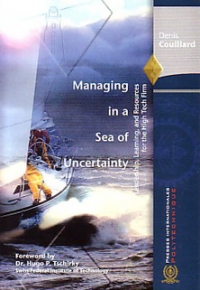

Managing in a Sea of Uncertainty
ISBN9782553011504
EditeurPresses internationales Polytechnique
pages272
Parution2006-01-23
AuteurDenis Couillard
Quatrième de couverture
Ebook : Revised version, May 2013
Technology management curricula typically comprise a variety of scientific disciplines: Management, Economics, Marketing, Engineering, Innovation Management and Social Sciences (e.g. Industrial Relations and Leadership). Practising managers wishing to improve their organization's chances of success are faced with a huge body of disconnected scientific knowledge. In seeking to improve their next management decision, they must somehow integrate and make sense of all that input.
This book, which is based on published research and illustrated by many examples drawn from industry practice, proposes two simple models for understanding the inter-relationships among the technology management concepts that underlie the management of a high tech organization. The ?Corporate Ship? analogy illustrates the dynamic nature of strategy making, and the need to reconcile the pursuit of short-term opportunity with long-term objectives in turbulent high technology environments. The ?Corporate Diamond? model uncovers the strong inter-relationships that exist between key concepts in technology management: leadership, learning, managing resources and developing successful new products and services.
Technology management curricula typically comprise a variety of scientific disciplines: Management, Economics, Marketing, Engineering, Innovation Management and Social Sciences (e.g. Industrial Relations and Leadership). Practising managers wishing to improve their organization's chances of success are faced with a huge body of disconnected scientific knowledge. In seeking to improve their next management decision, they must somehow integrate and make sense of all that input.
This book, which is based on published research and illustrated by many examples drawn from industry practice, proposes two simple models for understanding the inter-relationships among the technology management concepts that underlie the management of a high tech organization. The ?Corporate Ship? analogy illustrates the dynamic nature of strategy making, and the need to reconcile the pursuit of short-term opportunity with long-term objectives in turbulent high technology environments. The ?Corporate Diamond? model uncovers the strong inter-relationships that exist between key concepts in technology management: leadership, learning, managing resources and developing successful new products and services.
Argumentaire
QUESTIONS ANSWERED- How can an engineering driven company develop a market based strategy?
- Why develop a strategy if environment and opportunities change faster than that strategy can be executed?
- How can opportunities be chased if resources are not available to address them rapidly?
- How can resources be built and opportunities pursued if the weight of matrix organizations crushes initiative?
KEY RELATIONSHIPS CLARIFIED
- Higher Tech vs Lower Tech business environments?
- Market Orientation vs Learning?
- Learning vs Knowledge Management?
- Learning vs Core Competencies
- Core Competencies vs Technology?
- Management vs Leadership?
- Values vs Products?
TARGET AUDIENCE
- Graduate students and professors in Technology Management, Technology MBA, Executive MBA, Knowledge Management, Innovation Management and Industrial Relations/Strategic Human Resources Management study programs;
- High Tech companies CTOs, Directors in Strategic Marketing, Human Resources, and Engineering departments
- Venture Capitalists
- Consultants in strategic management, technology strategy, leadership, and/or organizational learning
WHO SHOULD BUY THIS BOOK
- Managers, Senior Managers, and General Managers in High Tech firms who wish to understand the key concepts of Management of Technology, and see how each of these concepts is successfully applied in industry;
- Students and professors who want to understand how the various fields of research in Management of Technology programs are interconnected to each others to form a useful, integrated view of strategic management in a High Tech firm;
BOOKS SPECIFICATIONS
- A simple, comprehensive view of technology management that draws on real life examples, and integrates over 400 books and articles on the subject;
- Concrete examples taken from over 120 High Tech companies and organisations, including Cisco Systems, Hewlett-Packard, Harris Corporation, General Electric, IBM, Shell, Sony, Honda, and IDEO;
- A text enriched with relevant and insightful quotes, regular concise summaries, 29 figures and 11 tables;
- Preface written by Hugo P. Tschirky of the Swiss Federal Institute of Technology in Zürich. Dr. Tschirky is a leading authority on Management of Technology (MOT) and on Enterprise Science whose academic and industrial activities span throughout Europe, the United-States, and Japan.
- A quick reference tool where chapters are key Management of Technology concepts, and sections deliver descriptions of key findings on each topic pertinent to managing in a High Tech environment. The book includes a comprehensive bibliography, an index of companies and organizations, and a general index.
Denis Couillard (M.Sc.A., P.Eng.) has held various management positions in engineering and marketing in the telecommunication industry where he helped launch several new technologies and products. He is currently Director of Products Innovation with Ultra Electronics, an international group designing, manufacturing and deploying sophisticated communications systems for international defence markets.
Chapter 1- Managing in high tech environments
Market, technology and competitive uncertainties.
Chapter 2 - The unique characteristics of high tech markets
Product development.
Chapter 3 - The challenge of developing new products and services in a high tech market
Market orientation.
Chapter 4 - Survival skills in uncharted waters: Learning and innovation
Learning teams and communities. Collaboration, innovation and adaptation. Total quality management (TQM). Information sharing and technologies. Managing knowledge.
Chapter 5 - Being prepared for the voyage: The company resources
Core competencies and technologies. Human resources and social capital. Alliances.
Chapter 6 - Getting there: Company leadership, structure and collaboration mechanisms
Evolution of structures, networks and virtual teams. Incentives, rewards and leadership development. Values, culture and vision. Value creation. Empowering leaders.
Chapter 7 - The Corporate Ship and the Corporate Diamond
Strategy. The Corporation as a ship. Ambitextrous leaders. The Corporate Diamond of asset, product and service creation.
Chapter 8 - Conclusion
Market, technology and competitive uncertainties.
Chapter 2 - The unique characteristics of high tech markets
Product development.
Chapter 3 - The challenge of developing new products and services in a high tech market
Market orientation.
Chapter 4 - Survival skills in uncharted waters: Learning and innovation
Learning teams and communities. Collaboration, innovation and adaptation. Total quality management (TQM). Information sharing and technologies. Managing knowledge.
Chapter 5 - Being prepared for the voyage: The company resources
Core competencies and technologies. Human resources and social capital. Alliances.
Chapter 6 - Getting there: Company leadership, structure and collaboration mechanisms
Evolution of structures, networks and virtual teams. Incentives, rewards and leadership development. Values, culture and vision. Value creation. Empowering leaders.
Chapter 7 - The Corporate Ship and the Corporate Diamond
Strategy. The Corporation as a ship. Ambitextrous leaders. The Corporate Diamond of asset, product and service creation.
Chapter 8 - Conclusion